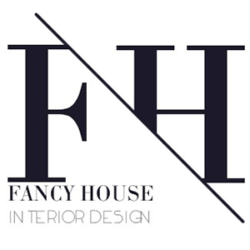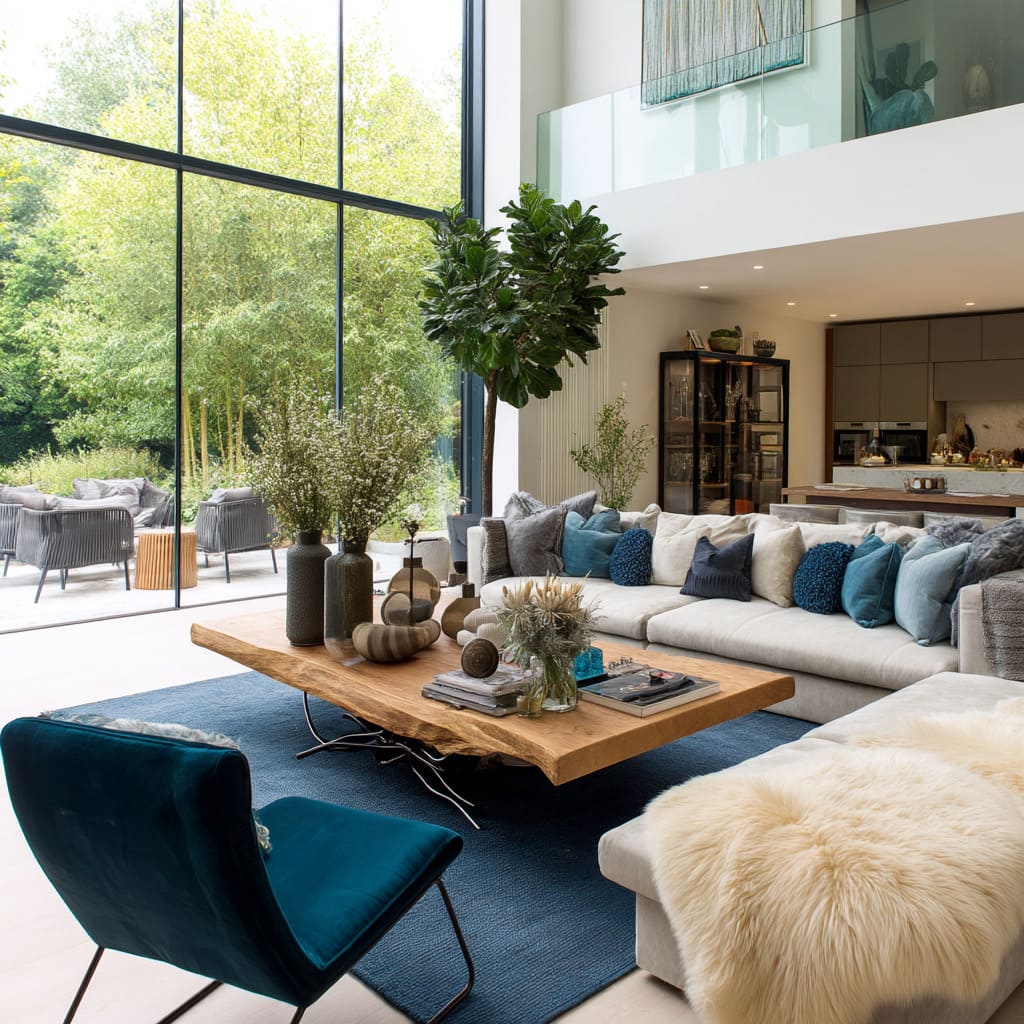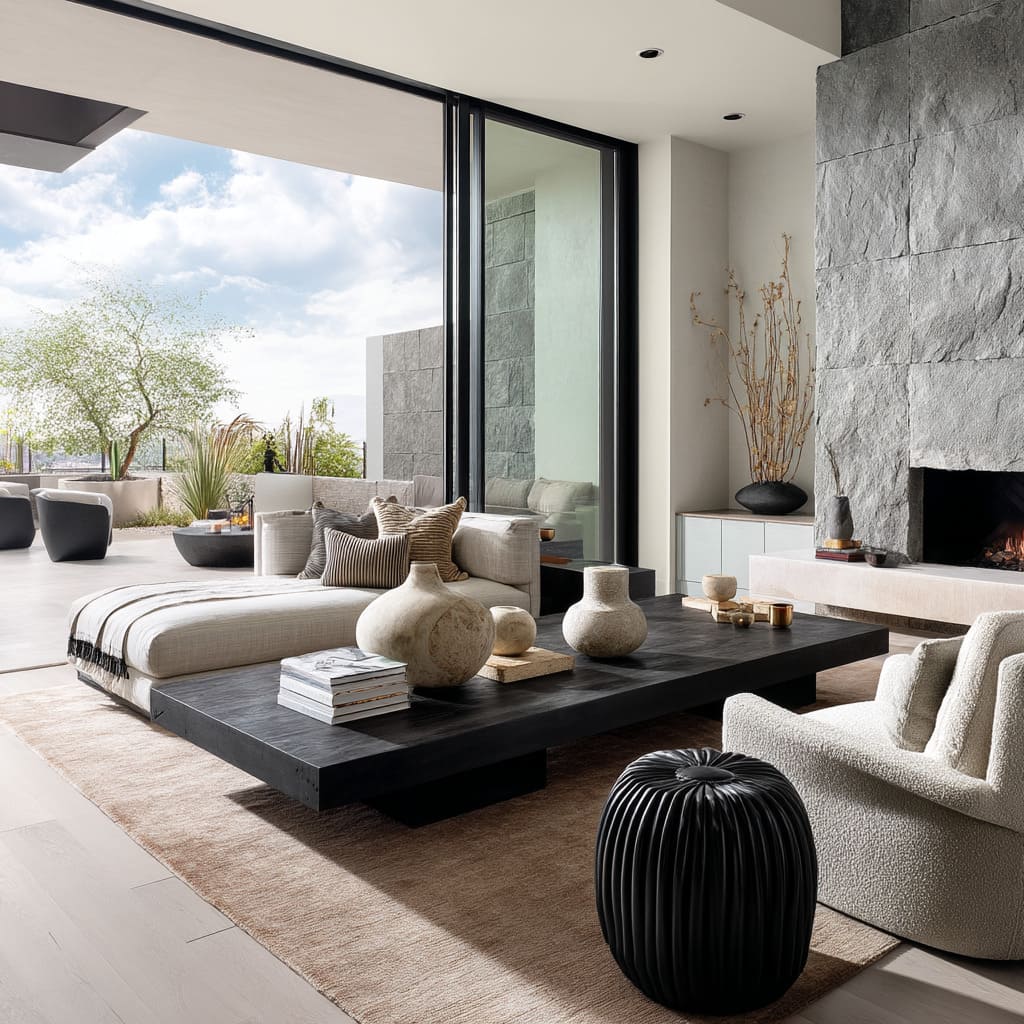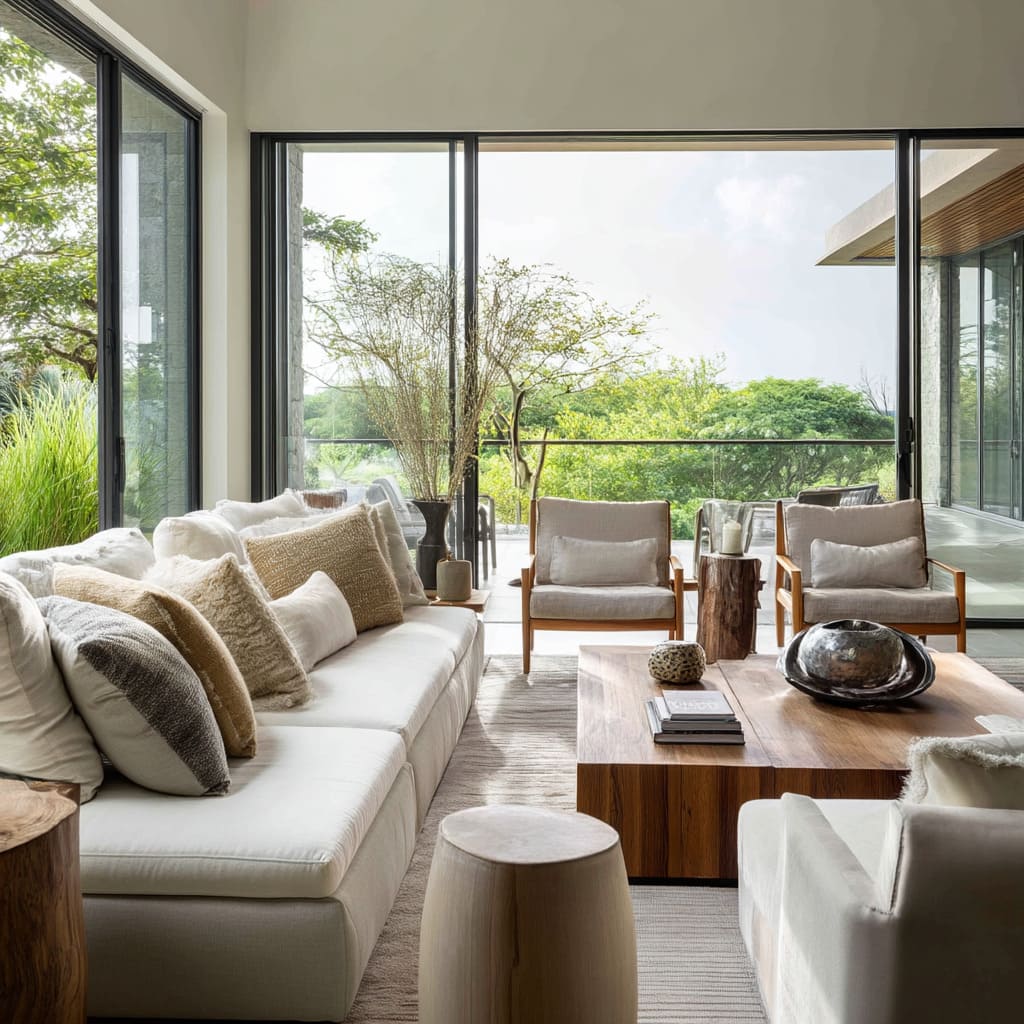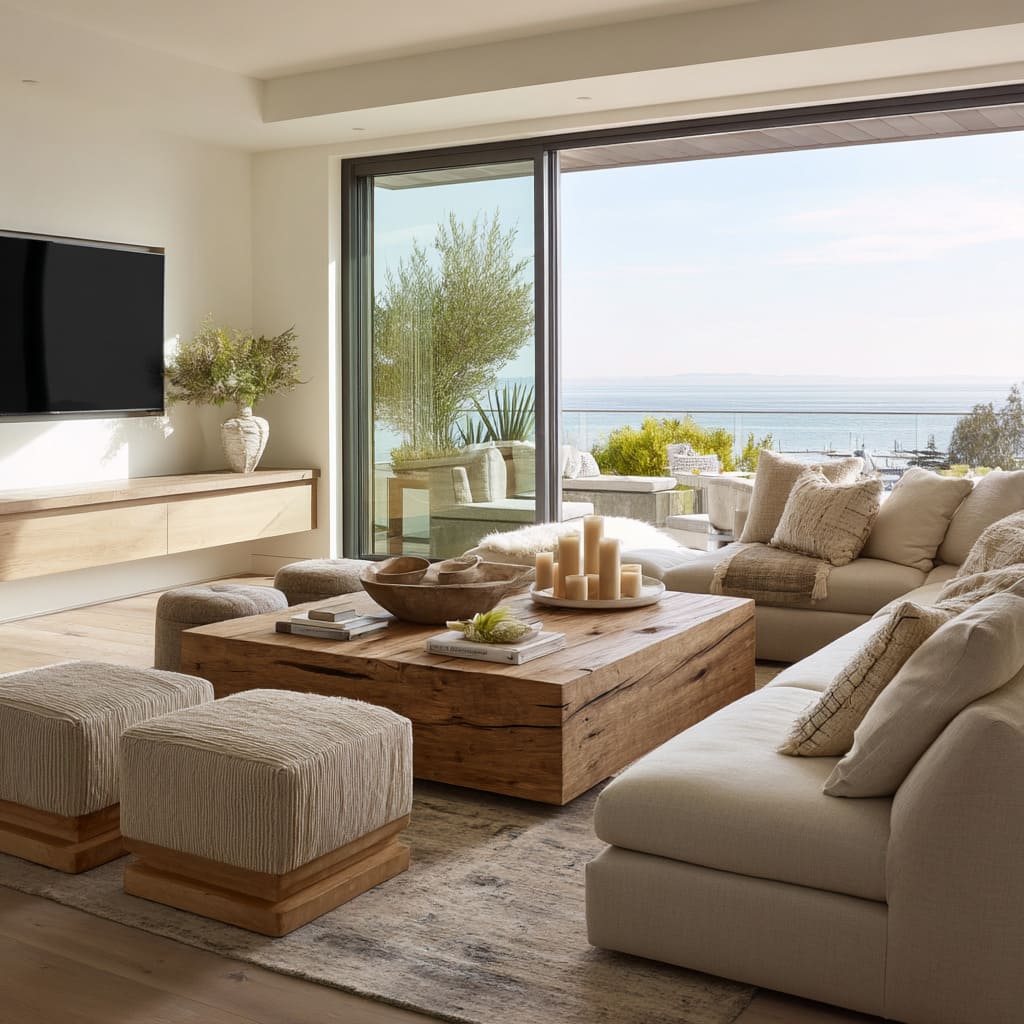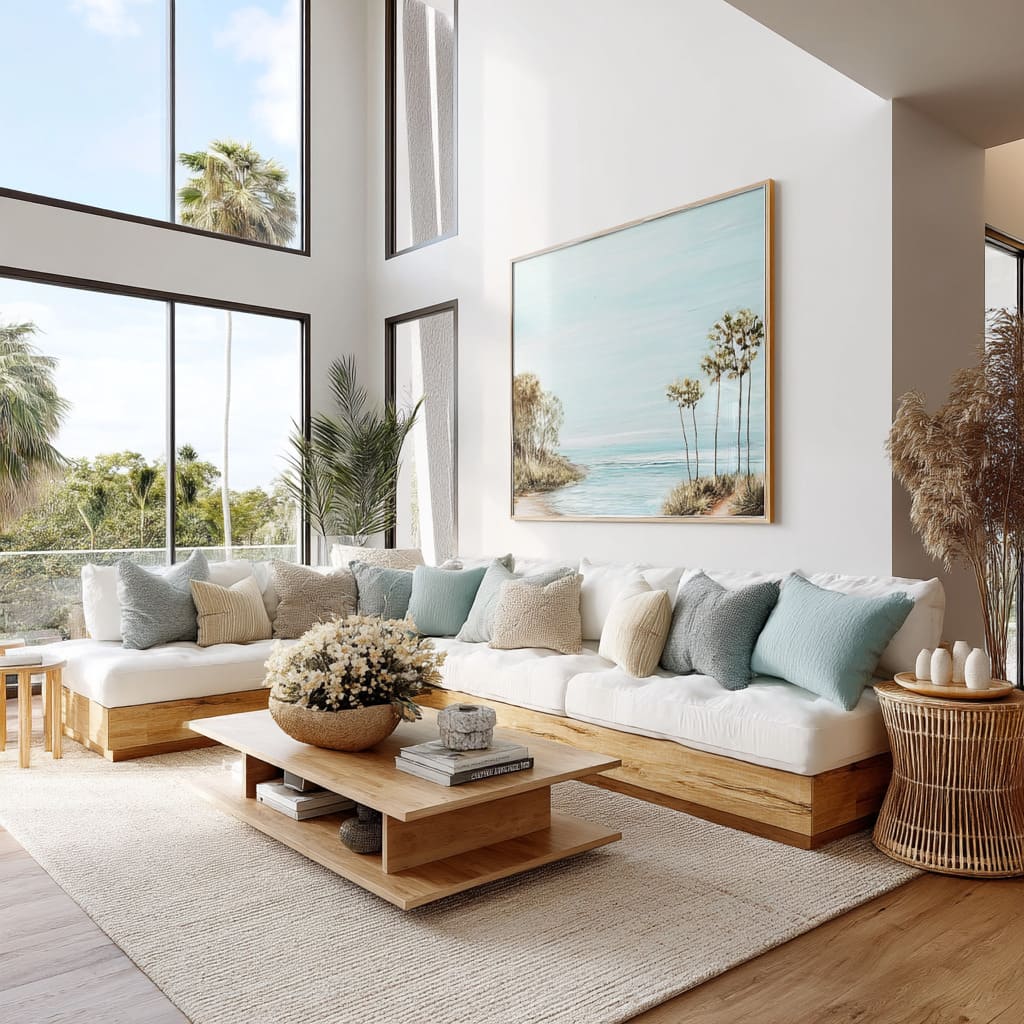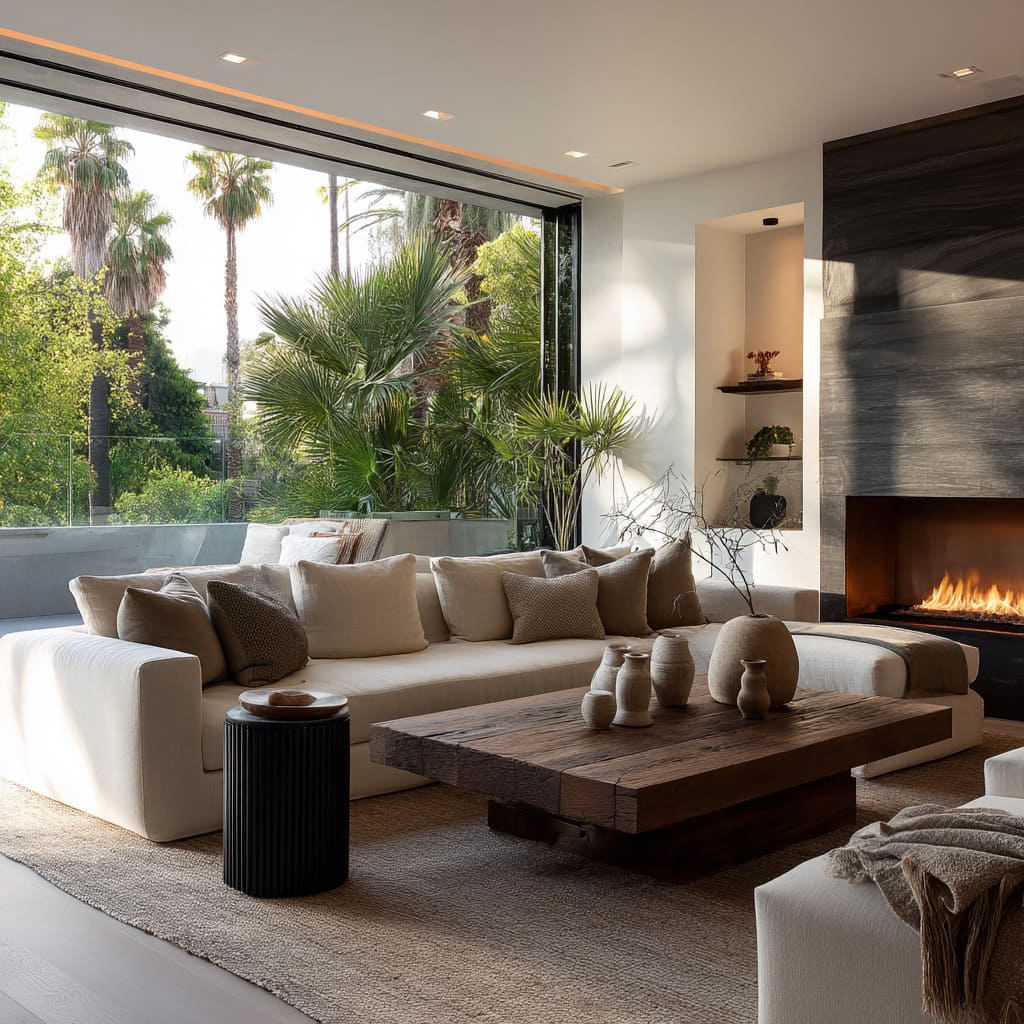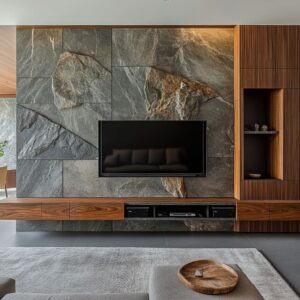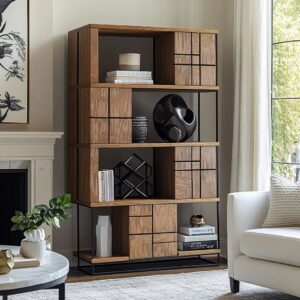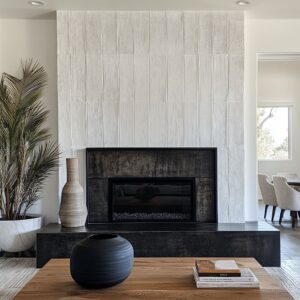Design trends in high-end living rooms have taken a noticeable turn—away from loud statements and toward rooms that feel grounded, refined, and intentional without being over-styled. From coastal homes to mountain retreats and glass-walled urban lounges, the current direction is marked by low-slung furniture, sculptural coffee tables, and neutral palettes where texture does the heavy lifting.
But the shift is in how these spaces use restraint. Designers are working with quiet contrasts—raw stone next to soft boucle, matte finishes beside subtle glass reflections, and greenery used with the kind of care usually reserved for artwork.
Instead of relying on bold colors or ornate details, the spaces are being built around proportion, natural light, and materials that hold character on their own. This article breaks down the subtle cues that define some of the most thoughtful modern luxury living room ideas right now.
You’ll see how volume, shadow, and even empty space are shaping the tone of modern comfort in ways that most people overlook. The insights here go deeper than trend lists—they show how good design decisions often work quietly in the background, guiding how a space feels without announcing themselves first.
Architectural Elements
Integrated Fireplace Walls
Modern luxury living room designs often showcase a fireplace that merges with or even masquerades as a structural wall feature. Designers use the finish itself—charred or layered wood, textured stone, or sleek plaster—to become a focal statement instead of relying on additional artwork.
This approach positions the fireplace as both functional and artistic, with material integrity guiding visual interest. Textured fireplace panels (e.g. , charred wood or ridged stone) vary the way light reflects throughout the day.
This not only reduces monotony on large surfaces but also accentuates the tactile character of the material, quietly animating the space.
Window Walls that Double as Design Framework
Expansive, carefully-framed glass walls allow nature to serve as living artwork. Whether the view includes an urban garden or sweeping coastal panorama, these designs frequently let glass dominate without heavy drapery or dramatic framing.
When indoor furniture lines or vertical elements echo the shape or proportion of the window grid, it creates continuity between architectural shell and furnishings. You’ll see repeated rectangles, crisp outlines, or elongated silhouettes that reinforce the geometry of the fenestration.
Subtle Transitions Between Inside and Out
Flooring, ceiling treatments, or fireplace materials frequently continue onto decks and patios, effectively dissolving the edge between interior and exterior. In some designs, the same tile or wood extends outside, making the living room appear larger and more connected to the landscape.
Even when materials change, color alignment or comparable textures ensure visual unity. For instance, a stone hearth in the interior might pair with a similarly toned concrete planter outdoors—together they expand the spatial feel without a fully open wall.
Furniture Shape and Massing
Low-Slung, Blocky Forms
Modern luxury living room ideas include sectional sofas and coffee tables with boxy proportions, grounded by thick bases or chunky silhouettes. This is not merely about comfort or a preference for minimal lines—it’s a visual strategy that “roots” the seating area, providing contrast with high ceilings and tall windows.
Weighty furniture forms anchor otherwise airy volumes. This is especially apparent in double-height rooms, where horizontal heft at floor level prevents the eye from drifting upward without a solid visual counterpoint.
Rounded vs. Angular
Sstrong rectangular shapes (sofas, hearths) are offset by circular or curved elements (side tables, vases, accent chairs). This interplay keeps the layout from feeling static.
Designers seem deliberate in toggling between soft and hard edges. Where a sofa is monolithic and squared, a curved armchair or cylindrical side table breaks the grid-like monotony, adding quiet vitality.
Layering of Heights
Usually coffee tables carry multiple objects at varying levels—stacks of books, a vase, a shallow bowl. In parallel, side chairs and ottomans often sit at subtly different elevations from the main sofa.
This height variation, though minimal, avoids uniformity and underscores a more curated, collected feel.
Textiles, Color, and Texture
Neutral-Heavy Palettes with Micro-Shifts in Tone
Contemporary luxury living rooms rely on pale neutrals—whites, creams, taupes—punctuated by occasional deep or earthy accents such as rust, charcoal, or navy. The effect is calm and unintrusive, yet highly layered through different textures.
Subtle variations in whites and beiges can be more dynamic than a single color block. Linen, boucle, and velvet in slightly different warm or cool whites create gentle depth, demonstrating an understanding of how minor hue changes read in person.
Tactile Contrast in Seating
Common textiles include wool-blend boucle, linen, brushed cotton, or faux sheepskin. Rougher surfaces, such as reclaimed wood coffee tables or textural stone, provide a counterpoint to softer fabrics.
The combination of near-matte surfaces (concrete, natural wood, textured stone) and plush textiles (boucle cushions, thick wool rugs) forms a refined tension that elevates neutrality beyond a bland scheme. In simpler terms, “soft meets raw” is a recurring rhythm.
Mixing Natural Fibers and Subtle Metallics
Though rarely the main focus, occasional metallic details—sculptural dishes, a lamp base, or minimal chair legs—add small glints. These touches are generally brushed or matte, preventing them from overwhelming the soft finishes.
Designers minimize the presence of reflective metals in favor of organic surfaces, emphasizing a feeling of calm. When metal appears, it often acts as a quiet, purposeful accent that draws the eye momentarily, then recedes.
Plants and Indoor-Outdoor Fusion
Placement with Intent, Not Just Decoration
From tall olive trees to broad-leafed tropical palms, greenery is used very selectively—often near windows, corners, or transitions. Designers balance a large window or door with a similarly scaled tree, achieving visual equilibrium without strict symmetry.
Plants often mimic outdoor shapes. For instance, an olive tree inside lines up with garden olives outdoors.
This “echo” approach ties the interior plant life to the exterior horizon, preserving continuity rather than simply filling empty corners.
Dried Florals as a Textural Layer
Rather than fresh floral centerpieces, dried grasses or branches frequently appear. This choice infuses an earthy texture, stands up well over time, and sidesteps the color demands of fresh bouquets.
The dryness and muted shades of these branches or grasses help them function as subtle sculpture. They shift focus to shape over color, in harmony with other neutrals in the space.
Lighting Strategies
Concealed, Recessed, and Barely There
Almost all modern luxury living rooms rely heavily on natural light by day, with overhead recessed fixtures as secondary illumination. Often, artificial lighting is tucked in recessed slots or minimal can lights that don’t disrupt the architectural flow.
Designers often position recessed lines or vents in alignment with structural elements or window frames, indicating that lighting and HVAC were planned in tandem with architecture. This “hidden infrastructure” approach avoids any fussiness on the ceiling plane.
Occasional Sculptural Fixtures
When a visible fixture appears—like a wooden floor lamp or a slim overhead pendent—its shape usually ties into the main furniture forms. It might echo the coffee table’s wood tone or an accent chair’s silhouette.
Larger fixtures seem to be chosen carefully to mirror either the geometry of the architectural lines or the organic shapes of the seating. This ensures no single piece steals focus unless that is the explicit intention.
Accessory Selection and Styling
Form Over Flash
Ceramics, vases, and bowls typically have matte finishes, with irregular shapes or artisanal quality. This runs counter to a traditional “polished luxury” look, illustrating a shift toward unvarnished, crafted objects.
The presence of handmade or rough-finish items acknowledges an appreciation for imperfection. Designers are purposefully showcasing craftsman details—scoring marks on wood, unglazed ceramic edges—as a way to add personality without color overload.
Balanced Groupings and Negative Space
Shelves and coffee tables often display a limited collection of objects—small stacks of books, a single carved form, one or two vases. Spacing is generous, letting each piece breathe and encouraging the eye to linger.
Negative space is as important as filled space. The ratio of decorative objects to open area signals curation.
Overloading surfaces would detract from the architectural lines and textured materials that form the foundation of these designs.
Color Subtext in Art and Accents
Artwork that Mirrors Surroundings
Rather than loud or dominant visuals, many pieces are subdued abstract works or tonal paintings that quietly align with the color palette. A pastel seascape might subtly echo an actual ocean view, or a textural canvas might repeat the vertical lines of a window.
Art tends to either reflect the environment (e. g.
, ocean tones, forest-like vertical strokes) or repeat architectural gestures (e. g.
, lines that match the fireplace planks). This synergy ensures art feels integral to the environment, not an afterthought.
Pops of Deeper Hues
When bolder color appears—like navy, copper, or deep teal—it’s usually confined to smaller accent pieces (pillows, a single chair, or a portion of a throw). This approach preserves an overall airy feeling while sparking visual rhythm.
Rather than saturating the room, these darker accent colors function as “anchoring notes. ” They often pull in from the window frames or complement the natural shadows created by structured lines in the space.
Zoning and Flow Without Physical Barriers
Low Furniture Placement to Define Zones
Sectionals, accent chairs, and rugs carve out seating clusters in open layouts. Even the difference between a tile and wood floor can subtly denote where one “room” ends and the next begins These subtle transitions allow the living area to feel separate but not closed off.
Avoiding full walls or drastic changes in elevation keeps the environment cohesive, which is key for residences that prioritize open-flow entertaining.
Outdoor Continuation
Many luxury modern designs replicate the interior seating shapes or color palette just outside on the patio or deck. Repetition of cushions or furniture lines ensures the living room’s “zone” carries outward for a seamless sense of continuity.
This continuity is deliberate: designers frequently use the same or complementary fabrics and finishes outside, so the boundary between inside and outside feels minimal. It’s a strategic choice that visually enlarges the living space and fosters a sense of extended relaxation area.
Conclusions: Key Strategic Observations
- Material Integrity as Decor: Designers often let architectural elements (fireplace cladding, structural wood) become the artwork, removing the need for excessive embellishment.
- Soft Meets Solid: Plush neutral seating is balanced by substantial, grounded coffee tables or textured stone, giving each space a sense of stability and cozy contrast.
- Subtle Tonal Layers: Soft whites, beiges, and muted earth tones are layered through multiple textures—linen, boucle, wool—rather than bold color patterns, creating a calm but richly detailed backdrop.
- Plants as Part of the Architecture: Greenery and dried florals are selected for scale and silhouette, anchoring corners or windows while mirroring outdoor forms.
- Minimal Visual Interruption: Recessed lighting, hidden HVAC, and low-profile furnishings underscore the concept of an unbroken visual plane, drawing the eye outward to nature or carefully arranged interior statements.
- Connecting Indoor and Outdoor Materials: Stone, wood, or tile finishes often bridge inside and outside, delivering a sense of unity and relaxed flow in spaces that value panoramic views.
By concentrating on the synergy between architecture, proportion, and textural variety, modern luxury living rooms now embrace a fresh kind of polished warmth. They prioritize calm neutrals, sculptural furnishings, tactile layering, and purposeful connections to outdoor environments—demonstrating that the most effective design statements often arise from nuanced detailing rather than overt spectacle.
